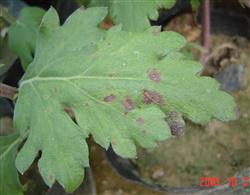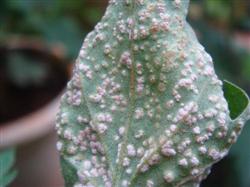Symptoms and pathogens of black spot of chrysanthemum

Chrysanthemum black spot, also known as brown spot, spot blight. The disease occurs in chrysanthemum cultivation areas. In addition to harming chrysanthemum, it can also damage many kinds of Compositae plants, such as wild chrysanthemum, chamomile, pyrethrum and so on. After the plant was damaged, the leaves of the light ones withered and fell off, and the serious ones died of the whole plant. Seriously affect the growth and ornamental of the plant. Symptom: the disease mainly harms the leaves of the plant. At the beginning of the disease, brown dots are produced on the susceptible leaves, and the spots gradually expand into round, oval or irregular shapes, black to dark brown. There is a clear boundary between the disease department and the health department. In the later stage of the disease, there are not obvious small black spots on the disease spot, which is the sexual spore organ of the pathogen. When the disease is serious, the plaques are connected to each other to form large plaques. Finally, the leaves blackened and died, hanging from the stem. The leaves of the susceptible plants began from the lower part and died upward in turn. Pathogen: the pathogen is a fungus of the genus Septoria chrysanthemella Sacc. It belongs to the subphylum Coleophora, Coleoptera and Chlorospora. The regularity of the disease: the pathogen overwintered on the remnant of the diseased plant with mycelium and conidia. In the following year, when the temperature was suitable, the conidium matured and produced conidia, and the conidia spread the harm by wind and rain. The optimum temperature for the development of pathogens was 22-27 ℃, and the disease began to occur about 15-30 days after infection. The disease can occur in the whole growing period of the plant. In the high temperature and rainy season or the plant is too dense, the disease develops rapidly. There were also some differences in resistance to black spot among different varieties. The susceptible varieties are purple butterfly, new big white, fire dance, purple dew condensation frost, crab claw yellow, fragrant white pear, Xi Shi drunken dance and Guitian music and so on. The varieties with strong disease resistance are lake last month, welcome spring dance, autumn color, jade peach, purple wild goose flying cream, purple cinnamon and so on. Prevention and treatment: ① in time to remove diseased plants, diseased leaves, eliminate the source of infection. After planting, the eliminated plants should be removed and destroyed in time to reduce the source of infection in the coming year. ② to strengthen cultivation management: select areas with good drainage, ventilation and light to plant chrysanthemums. Avoid continuous cropping. The soil of potted plants should be changed every year. Rational fertilization and pay attention to the proportion of nitrogen, phosphorus and potassium in order to promote the robust growth of plants and enhance disease resistance. Do not plant too densely, so that the plants have sufficient ventilation and light conditions. The varieties with poor disease resistance and low ornamental value of ③ should be eliminated as soon as possible. ④ medicament control: before the onset of the disease, spray 1-1-1-100 Bordeaux solution to prevent infection. During the onset of the disease, spray 75% chlorothalonil wettable powder 500,800 times, or 80% dimethoprim wettable powder 500,600 times, or 50% methyl thiophanate wettable powder 800-1000 times, once every 7-10 days, 2-3 times. The effect of alternating use of medicament is good.
- Prev

Control of Fusarium wilt of chrysanthemum
Fusarium wilt is one of the most important diseases of chrysanthemum. It has occurred in many areas of our country, although the incidence of the disease is not high, but it is extremely harmful. Once the plant is infected, if the control measures are not taken in time, it will lead to rapid plant death. Fusarium wilt of chrysanthemum is a fungal disease. The pathogen is Fusarium oxysporum, which is a kind of.
- Next

Control technology of chrysanthemum white rust
Chrysanthemums are loved by people because of their beautiful, bright and fragrant flowers. Growing flowers can cultivate people's sentiment, enrich cultural life, and improve physical and mental health. At the same time, some varieties of chrysanthemums can be eaten or used in medicine, which can be said to kill two birds with one stone. But in the process of cultivating and breeding chrysanthemums, they often suffer from a variety of diseases.
Related
- Fuxing push coffee new agricultural production and marketing class: lack of small-scale processing plants
- Jujube rice field leisure farm deep ploughing Yilan for five years to create a space for organic food and play
- Nongyu Farm-A trial of organic papaya for brave women with advanced technology
- Four points for attention in the prevention and control of diseases and insect pests of edible fungi
- How to add nutrient solution to Edible Fungi
- Is there any good way to control edible fungus mites?
- Open Inoculation Technology of Edible Fungi
- Is there any clever way to use fertilizer for edible fungus in winter?
- What agents are used to kill the pathogens of edible fungi in the mushroom shed?
- Rapid drying of Edible Fungi

